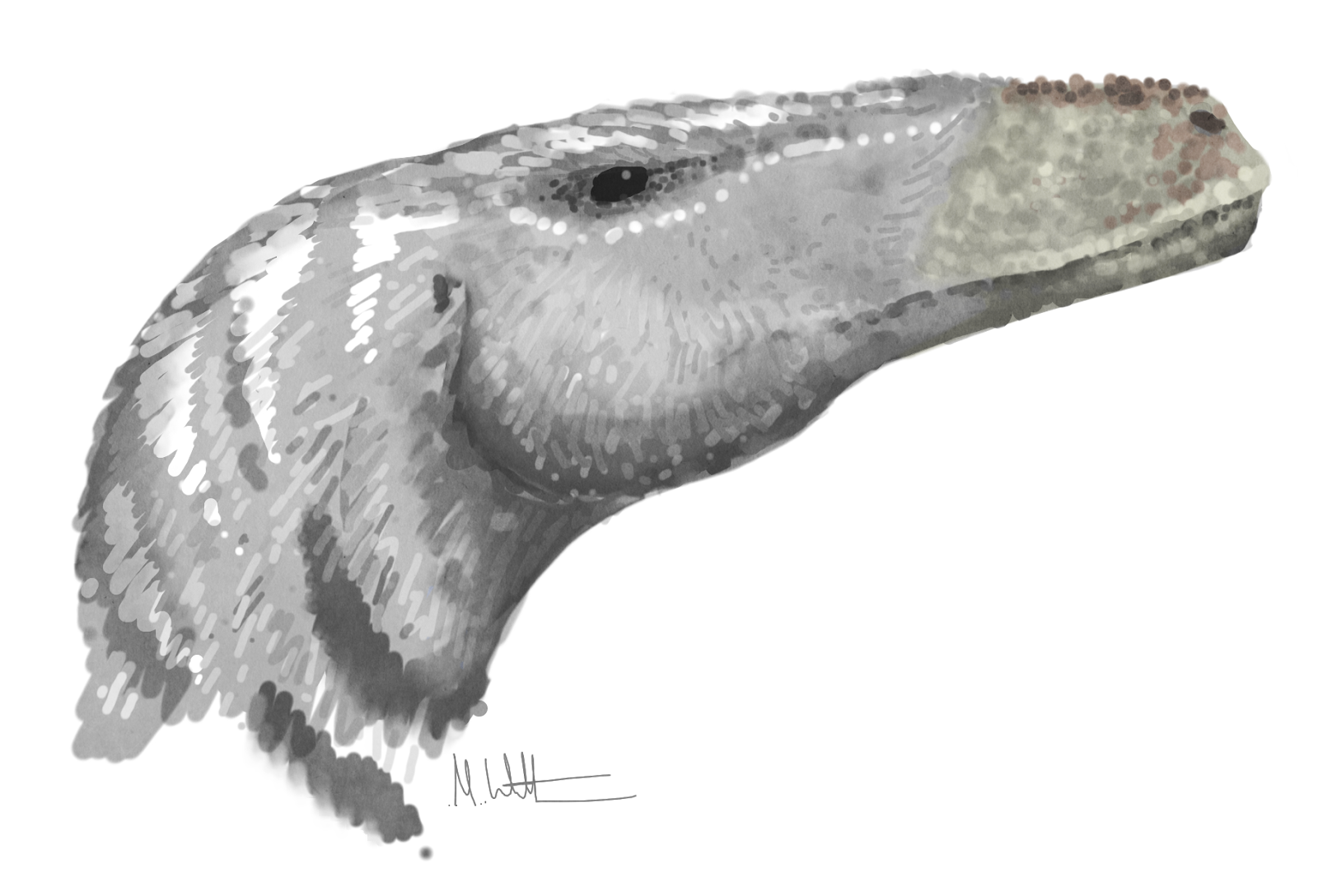 |
| Quick sketch of Deinonychus antirrhopus with expanded, bone-puncturing jaw muscles, a requirement of having a bite as strong as a modern alligator. Say what? Read on... |
Dromaeosaurids biting through steel bars - heck, any animal biting through steel bars, including hyenas - intuitively sounds like crazy talk*. But was Crichton at least right about the strong bites of dromaeosaurids? I've been doing some investigating on dromaeosaur jaw muscles for a new palaeoart commission, but I've come unstuck. Here's why.
*Is there any substance to claims about modern animals biting through steel? Given that tooth enamel is only very slightly harder than straight steel, I wonder how long teeth would last when gnawing through anything but the thinnest metal sheet.
For artists, Gignac et al.'s paper has important implications. Generating 8000 N of bite force requires a lot of muscle, so we might predict that Deinonychus jaws had the same swollen jaw muscles of modern crocodiles to generate all those bone-smashing newtons. This is at odds with other reconstructions of Deinonychus, where the jaw muscles do not atypically alter the contours of the face. I don't know how visible expanded, crocodile-like jaw muscles would be on deeply feathered maniraptorans, but reconstructions with sparse or naked faces would certainly need to take this on board. I've had a quick play about with this concept in the conservatively feathered Deinonychus above.
Problem is, Gignac et al.'s conclusions are not uncontested. Biomechanical assessments of Deinonychus jaws have found they were mechanically weak and ill-suited to delivering powerful bites (Therrien et al. 2005; Sakamoto 2010; Fowler et al. 2011). Therrien et al. (2005) estimated Deinonychus bite force at a relatively wimpy 15.7% of alligator jaw power, which Gignac et al. translate into 1450 N. This isn't unimpressive - as strong as that of a 30 kg wolf - but a far cry from an alligator-like bite, and certainly deflates our reconstructed jaw muscles to their traditional size. On the face of it, I certainly find the arguments for weak jaws more convincing. Hyenas and alligators have robust, wide and solidly-built skulls with generous room for jaw muscle placement, whereas the skull of Deinonychus is full of holes, is relatively narrow and slender, and with comparatively little room spaces jaw for muscles.
So, what to do? Jaws with relatively small muscles have been the norm in Deinonychus palaeoart since its discovery, but is it time we changed that? Were their jaws actually visibly and powerfully muscled as inferred by their trace feeding evidence, or is there something missing here? Is it significant that lower estimates of their bite forces match those of animals which can also puncture bone (wolves - see Haynes 1982)? If anyone has anything to add, please let me know...
References
- Fowler, D. W., Freedman, E. A., Scannella, J. B., & Kambic, R. E. (2011). The predatory ecology of Deinonychus and the origin of flapping in birds. PLoS One, 6(12), e28964.
- Gignac, P. M., Makovicky, P. J., Erickson, G. M., & Walsh, R. P. (2010). A description of Deinonychus antirrhopus bite marks and estimates of bite force using tooth indentation simulations. Journal of Vertebrate Paleontology, 30(4), 1169-1177.
- Haynes, G. (1982). Utilization and skeletal disturbances of North American prey carcasses. Arctic, 266-281.
- Sakamoto, M. (2010). Jaw biomechanics and the evolution of biting performance in theropod dinosaurs. Proceedings of the Royal Society B: Biological Sciences, 277(1698), 3327-3333.
- Therrien, F., Henderson, D. M., & Ruff, C. B. (2005). Bite me: biomechanical models of theropod mandibles and implications for feeding behavior. The carnivorous dinosaurs, 179-237.
